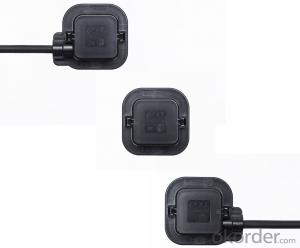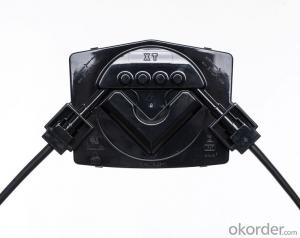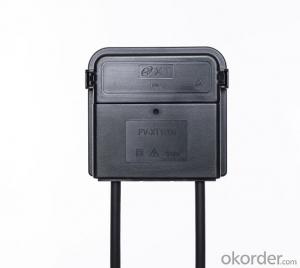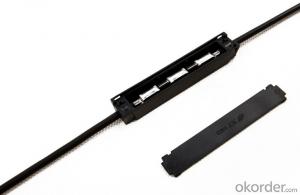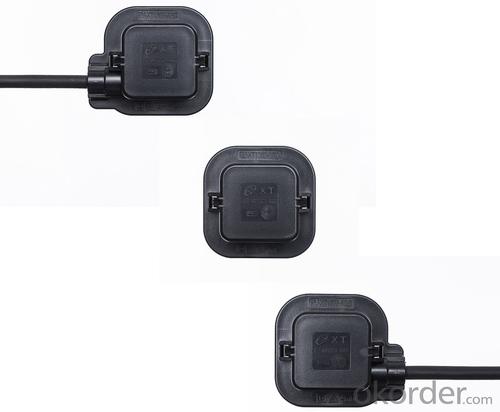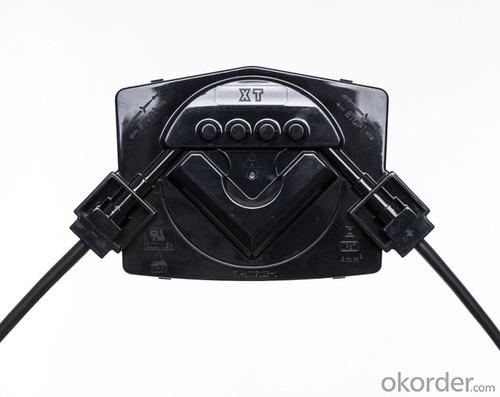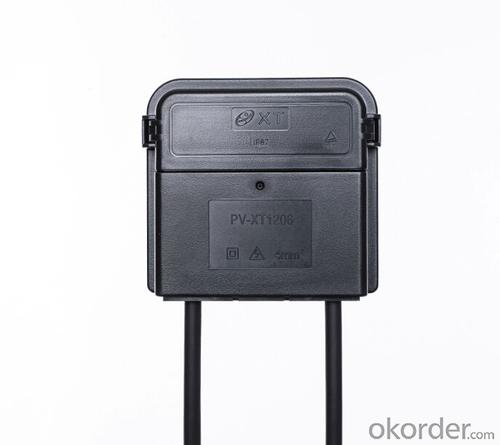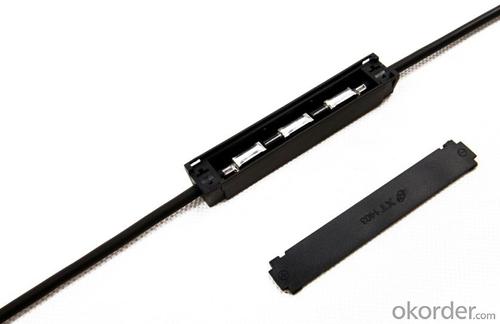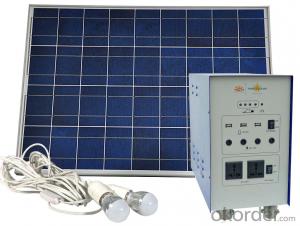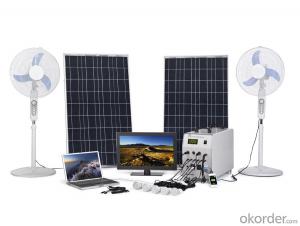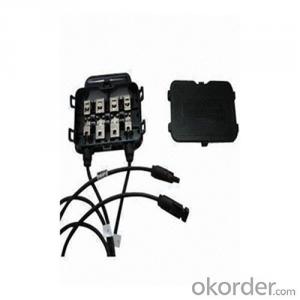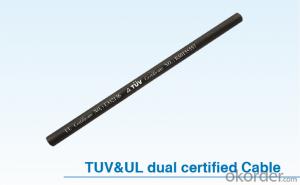Solar Energy Systems Ulverston PV Junction Box PV-1302 Split Design for Shortened Wiring - TUV, UL, ISO9001 Certified
- Loading Port:
- Guangzhou
- Payment Terms:
- TT OR LC
- Min Order Qty:
- 3000 pc
- Supply Capability:
- 3000000 pc/month
OKorder Service Pledge
OKorder Financial Service
You Might Also Like
Feature
a. split design, shortening wiring
b.use glue, excellent heat output
c. way of outlet, down and side optional
d.suitable for application of BIPV
Product description
1. All the connection made by double fixed connection low power loss
2. With the capacity of anti-aging and resistance to ultraviolet radiation on the outer cover with excellent box design with good thermal dissipation
3. Demonstrating safe, realiable and excellent lasting functionality, applicable in harsh outdoors working ambient
4. Big variety for choices,1 rail ,2 rail,3 rail,4 rail,5 rail,6 rail.mini junction box and solar junction box for solar street light
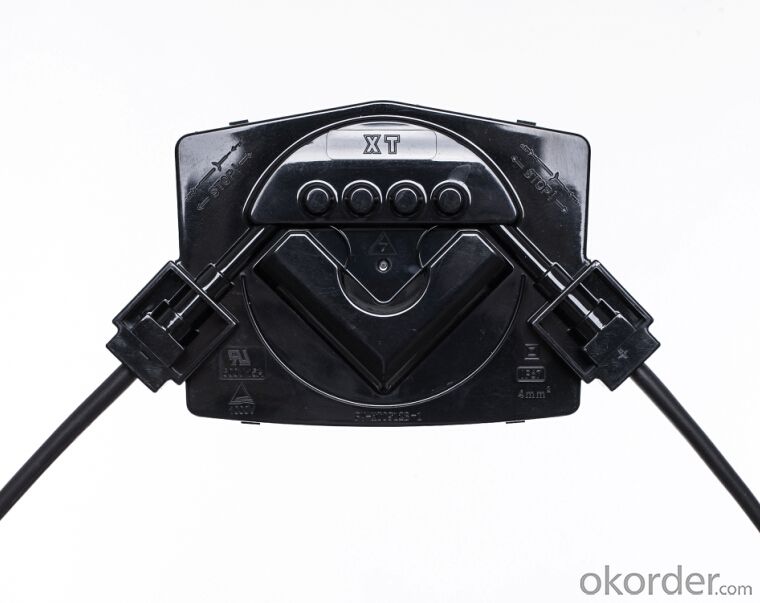
Item | Data |
Terminals for Ribbons | 2 |
Rated Current | 12A/15A |
Rated Voltage | 1000V/1500V |
Dimension | 67.4*51*15.5mm |
Temperature | -40℃~+85℃ |
Size of Cables | 4 mm2/12AWG |
Size of Ribbons | W(6±2mm)*T(0.3±0.15mm) |
Protection Degree | IP67 |
Flammability Class | V-0 |
FAQ
1. How long will my inquiry get response?
Your inquiry related to our products or prices will be replied within 24 hours.
2. Can I get professional service and suggestion?
Well-trained and experienced staffs to answer all your questions in fluent English.
3. Do you accept OEM or customized design?
OEM & ODM, any your customized lightings we can help you to design and put into product.
4. What if I need specific design?
Distributorship are offered for your unique design and some our current models.
- Q: Can solar energy systems be used in areas with limited roof space due to chimneys or vents?
- Indeed, solar energy systems can still function effectively in areas where roof space is restricted due to chimneys or vents. Although solar panels typically require unobstructed roof space to achieve optimal efficiency, there are alternative solutions accessible for areas with limited roof space. One feasible approach involves installing solar panels on adjacent flat or sloped surfaces, such as the ground or a nearby wall. These ground-mounted or wall-mounted solar systems can be adjusted to maximize exposure to sunlight, ensuring that the panels generate a substantial amount of energy. Another solution entails utilizing solar technologies specifically designed for limited roof space. For instance, solar tiles can be seamlessly integrated into the roof itself, replacing conventional roofing materials while simultaneously harnessing solar energy. These solar tiles can be installed around chimneys, vents, or any other obstructions on the roof, efficiently utilizing the available space. Furthermore, solar energy systems can be combined with other renewable energy sources, such as wind turbines or geothermal systems, to compensate for the limited roof space. By diversifying the sources of renewable energy, it becomes possible to meet the energy requirements of an area even with restricted roof space. In conclusion, despite the challenges posed by limited roof space due to chimneys or vents, there are still viable options for employing solar energy systems. By exploring alternative mounting options, utilizing solar tiles, or combining solar with other renewable energy sources, it becomes feasible to harness solar power in areas with restricted roof space.
- Q: Can solar energy systems be used in areas with limited space for ground-mounted installations?
- Yes, solar energy systems can be used in areas with limited space for ground-mounted installations. In such cases, alternative options like rooftop solar panels or solar canopies can be utilized to maximize the use of available space and still harness solar energy effectively.
- Q: How can I calculate the size of a solar energy system for my home?
- To calculate the size of a solar energy system for your home, you will need to consider a few factors. Here are the steps you can follow: 1. Determine your energy consumption: Start by examining your past energy bills to understand your average monthly energy usage in kilowatt-hours (kWh). This will give you an idea of how much electricity your solar system needs to generate. 2. Assess your location: The amount of sunlight your home receives depends on its location. Check the solar resource map for your region to estimate the average daily solar radiation in your area. This information will help you determine the solar panels' efficiency. 3. Calculate your energy needs: Multiply your average monthly energy usage in kWh by 12 to get your annual energy consumption. Divide this number by 365 to find your daily energy consumption. 4. Determine solar panel output: Solar panels have a wattage rating that indicates the amount of power they can generate under ideal conditions. Divide your daily energy consumption by the average daily solar radiation to estimate the number of solar panels you need. For example, if your daily energy consumption is 40 kWh and the average daily solar radiation is 5 kWh/m2, you would need an 8 kW solar system (40 kWh / 5 kWh/m2 = 8 kW). 5. Account for system losses: Solar systems experience losses due to factors such as shading, dirt, and inefficiencies in the inverter. To compensate for these losses, multiply the estimated system size by a derating factor, typically ranging from 0.75 to 0.9. This will give you the final system size you need. 6. Consult with a professional: It is always recommended to consult with a solar energy professional or installer who can conduct a site assessment and provide accurate calculations based on your specific home and energy needs. They will consider additional factors like roof orientation, available space, and local regulations to ensure an optimal solar system size for your home. Remember, the size of your solar energy system also depends on your goals, budget, and available space. A professional consultation will help you make an informed decision and maximize the benefits of solar energy for your home.
- Q: Can solar energy systems be used in powering electric fences or security systems?
- Certainly, electric fences or security systems can be powered by solar energy systems. The conversion of sunlight into energy by solar panels enables the generation of electricity, which can be stored in batteries or used directly to operate different devices. This renders solar energy systems a feasible and sustainable alternative for powering electric fences or security systems, particularly in remote or off-grid areas where conventional power sources may not be accessible or dependable. Solar-powered electric fences effectively discourage intruders or confine animals within a specific area, while solar-powered security systems provide continuous surveillance and monitoring without the requirement of a constant electricity supply. Moreover, solar energy systems are eco-friendly and aid in reducing carbon emissions related to traditional power sources, thus becoming an increasingly sought-after and cost-efficient solution for diverse applications, including electric fences and security systems.
- Q: Can solar energy systems be used for powering factories?
- Yes, solar energy systems can certainly be used for powering factories. Solar panels can be installed on the rooftops or open spaces around factories to capture sunlight and convert it into electricity. This renewable energy source can provide a significant portion or even the entire energy needs of a factory, reducing reliance on non-renewable sources and lowering carbon emissions.
- Q: What is the impact of bird droppings on the performance of solar panels?
- Bird droppings can have a significant impact on the performance of solar panels. When bird droppings land on the surface of solar panels, they can create a layer that reduces the amount of sunlight reaching the photovoltaic cells. This results in a decrease in the overall efficiency of the panels and a subsequent reduction in power generation. The composition of bird droppings, which includes various organic and inorganic substances, can also lead to the formation of a film or crust on the surface of the solar panels. This film can trap moisture and dust, further obstructing the sunlight and leading to additional energy losses. Furthermore, the acidic nature of bird droppings can cause corrosion on the metallic components of the solar panels. This corrosion can damage the electrical connections and affect the overall longevity and performance of the panels. To mitigate the impact of bird droppings on solar panel performance, regular cleaning and maintenance are essential. Timely removal of bird droppings is crucial to ensure optimal sunlight exposure and prevent any potential damage. Additionally, installing bird deterrents or protective measures, such as bird spikes or netting, can help minimize the frequency of bird droppings on solar panels, thus reducing their negative impact.
- Q: Can solar energy systems be used for powering off-grid research stations in Antarctica?
- Yes, solar energy systems can be used for powering off-grid research stations in Antarctica. Solar panels can be installed to capture sunlight and convert it into electricity, which can then be stored in batteries for use during periods of low sunlight. This renewable energy source is a viable and sustainable option for powering remote research stations in Antarctica, reducing reliance on fossil fuels and minimizing environmental impact.
- Q: Can solar energy systems be used in areas with limited access to maintenance services?
- Yes, solar energy systems can be used in areas with limited access to maintenance services. Solar panels are relatively low-maintenance and durable, requiring minimal upkeep. They do not have moving parts that can wear out, and regular cleaning is often the only maintenance required. Additionally, advancements in technology have made solar systems more reliable and efficient, reducing the need for frequent maintenance.
- Q: What is the role of solar concentrators in solar energy systems?
- Solar concentrators play a crucial role in enhancing the efficiency of solar energy systems by concentrating sunlight onto a smaller area, thereby increasing the intensity of the light. This concentrated sunlight can then be converted into electricity or used for heating purposes, maximizing the energy output from the solar panels or thermal collectors.
- Q: Can solar energy systems be connected to the grid?
- Yes, solar energy systems can be connected to the grid. This is known as grid-tied or grid-connected solar power. By connecting to the grid, excess electricity generated by the solar system can be fed back into the grid, allowing for a two-way flow of electricity and enabling homeowners or businesses to earn credits for the surplus energy they produce.
Send your message to us
Solar Energy Systems Ulverston PV Junction Box PV-1302 Split Design for Shortened Wiring - TUV, UL, ISO9001 Certified
- Loading Port:
- Guangzhou
- Payment Terms:
- TT OR LC
- Min Order Qty:
- 3000 pc
- Supply Capability:
- 3000000 pc/month
OKorder Service Pledge
OKorder Financial Service
Similar products
Hot products
Hot Searches
Related keywords
